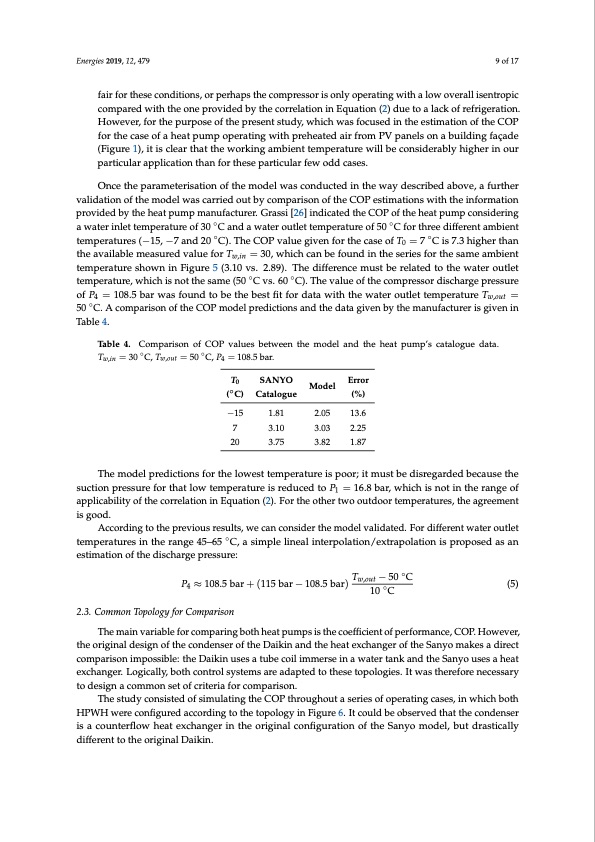
PDF Publication Title:
Text from PDF Page: 009
Energies 2019, 12, 479 9 of 17 fair for these conditions, or perhaps the compressor is only operating with a low overall isentropic compared with the one provided by the correlation in Equation (2) due to a lack of refrigeration. However, for the purpose of the present study, which was focused in the estimation of the COP for the case of a heat pump operating with preheated air from PV panels on a building façade (Figure 1), it is clear that the working ambient temperature will be considerably higher in our particular application than for these particular few odd cases. Once the parameterisation of the model was conducted in the way described above, a further validation of the model was carried out by comparison of the COP estimations with the information provided by the heat pump manufacturer. Grassi [26] indicated the COP of the heat pump considering a water inlet temperature of 30 ◦C and a water outlet temperature of 50 ◦C for three different ambient temperatures (−15, −7 and 20 ◦C). The COP value given for the case of T0 = 7 ◦C is 7.3 higher than the available measured value for Tw,in = 30, which can be found in the series for the same ambient temperature shown in Figure 5 (3.10 vs. 2.89). The difference must be related to the water outlet temperature, which is not the same (50 ◦C vs. 60 ◦C). The value of the compressor discharge pressure of P4 = 108.5 bar was found to be the best fit for data with the water outlet temperature Tw,out = 50 ◦C. A comparison of the COP model predictions and the data given by the manufacturer is given in Table 4. Table 4. Comparison of COP values between the model and the heat pump’s catalogue data. Tw,in = 30 ◦C, Tw,out = 50 ◦C, P4 = 108.5 bar. T0 SANYO Model (◦ C) Catalogue Error (%) −15 1.81 2.05 13.6 7 3.10 3.03 2.25 20 3.75 3.82 1.87 The model predictions for the lowest temperature is poor; it must be disregarded because the suction pressure for that low temperature is reduced to P1 = 16.8 bar, which is not in the range of applicability of the correlation in Equation (2). For the other two outdoor temperatures, the agreement is good. According to the previous results, we can consider the model validated. For different water outlet temperatures in the range 45–65 ◦C, a simple lineal interpolation/extrapolation is proposed as an estimation of the discharge pressure: P4 ≈ 108.5 bar + (115 bar − 108.5 bar) Tw,out − 50 ◦C (5) 10 ◦C 2.3. Common Topology for Comparison The main variable for comparing both heat pumps is the coefficient of performance, COP. However, the original design of the condenser of the Daikin and the heat exchanger of the Sanyo makes a direct comparison impossible: the Daikin uses a tube coil immerse in a water tank and the Sanyo uses a heat exchanger. Logically, both control systems are adapted to these topologies. It was therefore necessary to design a common set of criteria for comparison. The study consisted of simulating the COP throughout a series of operating cases, in which both HPWH were configured according to the topology in Figure 6. It could be observed that the condenser is a counterflow heat exchanger in the original configuration of the Sanyo model, but drastically different to the original Daikin.PDF Image | Comparison of Transcritical CO2 and Conventional Refrigerant Heat Pump

PDF Search Title:
Comparison of Transcritical CO2 and Conventional Refrigerant Heat PumpOriginal File Name Searched:
energies-12-00479.pdfDIY PDF Search: Google It | Yahoo | Bing
CO2 Organic Rankine Cycle Experimenter Platform The supercritical CO2 phase change system is both a heat pump and organic rankine cycle which can be used for those purposes and as a supercritical extractor for advanced subcritical and supercritical extraction technology. Uses include producing nanoparticles, precious metal CO2 extraction, lithium battery recycling, and other applications... More Info
Heat Pumps CO2 ORC Heat Pump System Platform More Info
| CONTACT TEL: 608-238-6001 Email: greg@infinityturbine.com | RSS | AMP |